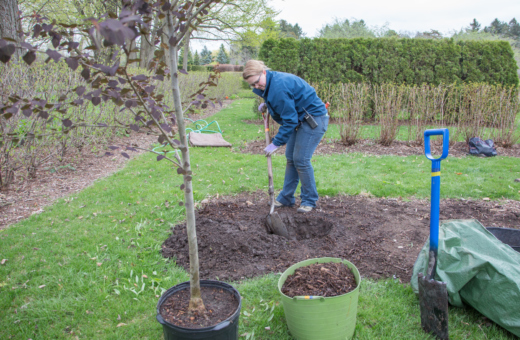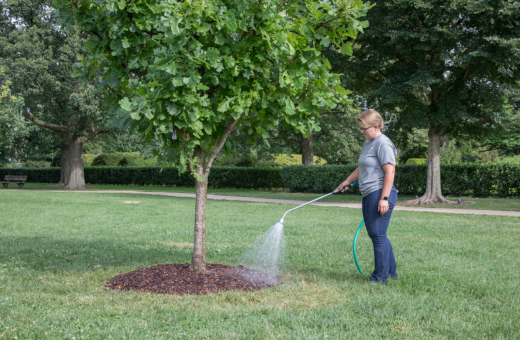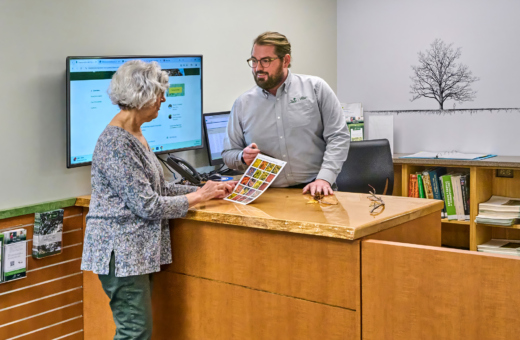Shop Smart at the Arbor Day Plant Sale
The Arbor Day Plant Sale at The Morton Arboretum is a great opportunity to choose among thousands of perennials, vegetables, herbs, trees, and shrubs carefully chosen for Chicago-area growing conditions, with expert Plant Geniuses on hand to answer questions and suggest plants.
This year’s sale will be held Thursday, April 24, through Saturday, April 26. Shoppers must purchase timed tickets in advance, with the cost of the ticket applied as a credit to the plant purchase.
If you’re new to the plant sale, learn how it works, and check out these tips to make the most of your shopping experience:
Bring information about your planting site. Take a look around your yard before you come to the sale. Make some notes about the sun or shade conditions in your yard, the size of the bed you’re looking to plant, and what else is growing nearby (such as overhanging trees). If possible, bring pictures of the planting site on your phone. “Measure any target area you’re shopping for, so you can figure out how many plants you will need to buy to fill it,” said Heather Prince, a garden designer, Arboretum education program instructor, and longtime Plant Genius. The more information you can give to the Plant Geniuses, the better they can help you choose the perfect plant.
Wear comfortable shoes. The plant sale is in the Arboretum’s Vehicle Storage Building, laid out on a concrete floor with large doors open to the weather. Dress appropriately so you can linger and browse.
Be open to possibilities. Come in with general criteria, such as “cherry tomatoes” or “shade perennials,” rather than having your heart set on a particular plant. The available plant selection changes from year to year, so there’s no guarantee that a plant you saw last year will be on sale this year.
Look for native plants. Straight-species native perennials will be in their own section. Nativars—named selections or cultivars of native plants—will be included in the general perennial sections, such as “Sun Perennials” and “Grasses,” but the plant information signs will identify them. Native trees and shrubs will be in the “Trees” and “Shrubs” sections.
Seek out pollinator-friendly plants. Look for a colorful plastic bee or butterfly on the plant information signs of plants that are especially beneficial to pollinating insects. Remember that trees and shrubs, as well as perennials, can provide nectar and pollen.
Try something new. “Jump in and explore,” Prince said. “The sale is meant to be a broad array of different kinds of plants, so while many of them will be natives, most are not.”
If you love a plant, buy it! Some plants do sell out, so don’t count on a plant remaining available while you ponder whether to choose it.
Consider containers. “Plant a hosta or heuchera in a pot, and water and fertilize it the way you would flowering annuals, and it can be spectacular,” said Kris Bachtell, vice president of collections and horticulture. Plan to transplant them into the ground at the end of the growing season. Shrubs or small trees, such as Japanese maples, also can be planted in containers if you have a sheltered but unheated place to overwinter them and protect their roots. The container gardens at the Arboretum are all designed around potted trees and shrubs that are grown this way.
Buy enough plants. “In general, planting shrubs or perennials in odd numbers, such as three or five, makes it feel like a group,” Prince said.
Get great tomatoes. Among the popular offerings are grafted tomatoes—flavorful heirloom varieties that have been grafted onto disease-resistant rootstocks. “Because of the disease resistance, the root system is so good that the plant is more healthy and it produces great yields,” Bachtell said. Arboretum staff raise these plants from seed and do the grafting.
Plan for what comes next. Think about what you’ll do with the plants when you get them home. In late April, it’s fine to plant hardy trees, shrubs, or perennials out in the garden, but the soil is still too cold and the weather is too risky for tender vegetables and herbs such as tomatoes, peppers, and basil. They will need to be protected from frost until at least the middle of May before you can plant them.
Protect young trees and shrubs. These plants will be small enough for you to carry them and plant them unaided, but that means their thin bark and buds may be vulnerable to hungry animals. “Consider some protection against bunnies,” Prince said. “A little bit of chicken wire can go a long way.”
Ask questions. “Plant Geniuses are here to help and we love, love, love to talk plants,” Prince said. Look for neon-yellow T-shirts that say “Plant Genius.”
Take a bow. When you shop at the Arbor Day Plant Sale, you’re doing good work. Your purchases at this fundraising event support all The Morton Arboretum’s work for a greener, healthier, more beautiful world where people and trees thrive together. The funds raised support science and conservation work locally, nationally, and globally; help care for the Arboretum’s magnificent landscape and its tree collections; improve tree care and tree planting in local communities; and offer education and outreach. Learn more about how your plant sale purchases help trees and people.



